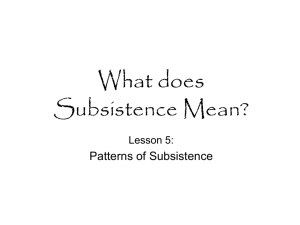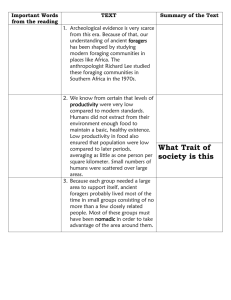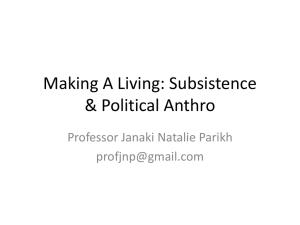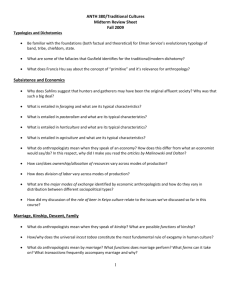CULTURAL ANTHROPOLOGY CH 5
advertisement
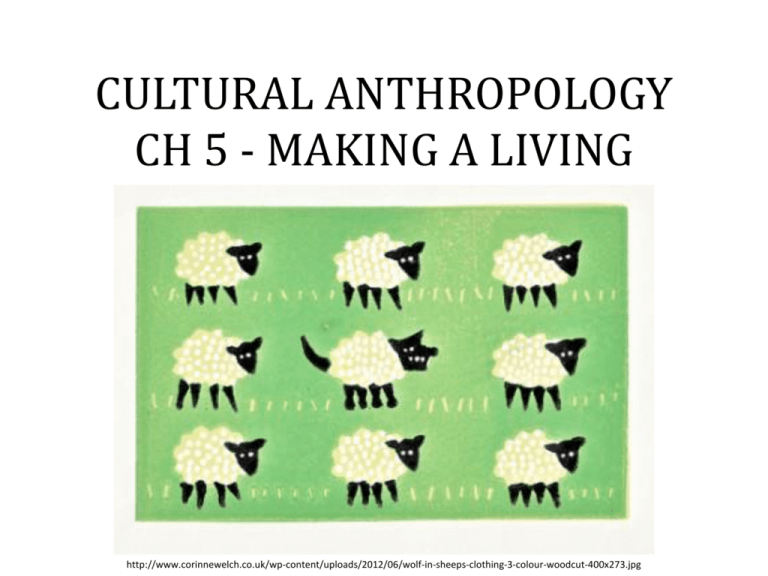
CULTURAL ANTHROPOLOGY CH 5 - MAKING A LIVING http://www.corinnewelch.co.uk/wp-content/uploads/2012/06/wolf-in-sheeps-clothing-3-colour-woodcut-400x273.jpg If you had to hunt and gather your own food, where would you live? COLD COOL MILD http://www.mnr.gov.on.ca/en/Business/ClimateChange/2ColumnSubPage /STDPROD_090063.html ADAPTATION ADAPTATION – KEY TERMS Adaptation: The way organisms modify or adjust to their environments to fulfill their needs Anthropogenesis: The process whereby ecosystems are influenced or altered by humans Carrying Capacity: The number of people the available resources can support at a given technological level Culturally Conditioned Bias: The assumption that our own culture is best, and that different or older cultures are less progressive Ecosystem: A functioning system composed of both the physical environment and the organisms within it. Human ecosystems often must be interpreted in cultural terms Horticulture: Cultivation of crops using hand tools such as digging sticks of hoes Patterns of subsistence: Food-procuring strategies ADAPTATION establishes a moving balance between needs of a population and the potential of its environments The Tsembaga (Papa New Guinea) -A horticulture society, mostly vegetarian --Also raises pigs, but only eats them during times of need (illness, injury, warfare) or during times of celebration Tsembaga Pig Sacrifice -Because of prestige, the pigs were rarely killed, population would grow -Eventually, their food needs would compete with that of the people -The need to expand food production to meet everyone’s needs would lead to warfare between groups -After warfare, festivals were held and the pigs were eaten to celebrate the end of hostilities -In peaceful times, festivals would be held to eat the pigs and reduce the strain on food --the cycle of fighting and feasting ensured a balance between humans, land, and animals ADAPTATION also refers to: 1. the interaction process between changes an organism makes to its environment AND 2. The change the environment makes to an organism Sickel-cell Anemia vs. Malaria -Affecting populations of Central African decent --a genetic mutation causing the red blood cell to deform and become rigid --people who inherited gene from both parents would die in childhood --this selective pressure kept the gene from spreading BUT THEN... -Slash-and-burn horticulture caused a change in the environment -This caused mosquito populations carrying malaria to increase -Malaria enters red blood cells and can be fatal -However, people who receive the sickle-cell gene from only one parent have a natural defense (antidote) -These people didn’t succumb to Malaria, and because of they were favoured by natural selection, the sickle-cell gene started to increase again. SO... People change the environment (slash-and-burn horticulture) and the environment changes them (increase in sickle-cell gene) ADAPTATION can also be viewed through human ecology -Human ecology borrow from concepts of natural ecology. -An ecosystem is composed of the physical environment and the living organisms within it; an important part of this environment for humans is culture -For example, with the Tsembaga, consuming pigs is not simply economical, but it is also social and spiritual. ADAPTATION can also be viewed through a historical lens For example, from about 3500BC until the 17th century, aboriginal peoples in southern Quebec maintained a way of life that was in balance with their resource base. Then the Europeans arrived. Ojibwe Nation The Ojibwe lived on the northern shores of Lake Huron and Superior -They live in small families for most of the year -They hunted moose, deer, bear, and beaver; also gathered food Sugar camp http://theplainsofaamjiwnaang.wordpress.com/2009/12/02/lifestyle-andworldview-of-the-ojibwa/ -Fall: Fishing, Spring: Maple syrup, Summer: Harvest wild rice on water banks -Fairly sedentary and abundant lifestyle Then the Europeans arrived -Ojibwe engaged in the fur trade -Lured to Saskatchewan and Manitoba for new trapping grounds -Adopted the plains nomadic lifestyle, becoming bison hunters and accepting rituals such as the Sun Dance http://new.wildaboutgardening.org/en/growing/section3/ecozone_map/index.htm -They didn’t completely abandon their woodlands heritage -continued to make maple syrup and fish -Became famous for their herbal remedies (Midewiwin) -Their floral art was adopted by plains nations FOOD-FORAGING Which is a better way of life? OR Foraging • 90% of humans who have lived were foragers, supporting themselves on a combination of wild plan collection, hunting and fishing. • They lived in the best environments in the world, had well balanced diets, and considerable leisure time. • Examples of cultures that used subsistence strategies based on foraging: 1. The Ju/’hoansi (Kalahari Desert, Africa) 2. The Blackfoot (North American Prairies) THE FOOD FORAGING WAY OF LIFE Is it really primitive, backwards and undeveloped? Blackfoot Confederacy -Nations living in Alberta and Montana that foraged and hunted Bison -Band membership fluctuated depending on the season and availability of food -Bands came together in the summer for feasting and religious rituals -Movement patterns throughout the year were relatively fixed THE FOOD FORAGING WAY OF LIFE Is it really primitive, backwards and undeveloped? Ju/hoansi [zhutwasi] Kalahari Desert, Africa -20 hour work week, less than contemporary Western industrial societies -A diet that meets and even exceeds modern nutritional guidelines -balanced life of work, love, ritual, play -Because of these factors,, anthropologists have labelled them the “original affluent society” because http://www.jelldragon.com/theoldways/grashoek.htm THE FOOD FORAGING WAY OF LIFE Is it really primitive, backwards and undeveloped? Are modern day food-foragers they way they are because they don’t know any better? -Most foragers have had some interaction with other food producing cultures -the Ju/’hoansi trade with Bantu farmers -The Mbuti (also foragers) live closely with Bantu- and Sudanic-speaking farmers -In the 1980’s, a global recession led to the abandonment of many sheep stations in Australia, leading to large numbers of unemployment. Many Aboriginal people returned to foraging for subsistence. Not only were they well fed, but they didn’t rely on any governmental assistance during the rest of the recession -Modern day foragers choose to maintain that lifestyle, not because of ignorance, but because of informed choice. Characteristics of Food Foragers Characteristics Key Points Mobility and Technology -Food foragers do not form or practice animal husbandry -Must live where food sources are available -wandering but is done within a fixed territory -composition and size of social groups varies regionally and seasonally Camp Organization -The amount of people a group can contain based on economical factors - Carrying Capacity puts food resources against the number of people -Density of social resources which is the number or intensity of interaction between people Examples -Ju/’hoansi, depend on the reliable and highly droughtresistant mon-gongo nut, may keep to fairly fixed annual routes and cover only a restricted territory -Mi’kmaq traditionally lived in winter camps composed of a few related families. They hunted seal, beaver, moose, and caribou, while in summer, when resources were more plentiful, especially fish, they formed bonds of several hundred people. An example of camp organization is the Ju/’hoansi and the Blackfoot. Camp organization in the Ju/”hoansi is dependant on social influences, people leave when they get tired of their group or experience conflicts. Whereas, camp organization in the Blackfoot is dependant on food availability wherein people separate into smaller groups at different times of the year to hunt for food. Better or worse than Toronto, and Why? Division of Labour - A crucial component of social organization and cooperation Men and women have different tasks Food Sharing Egalitarian Society - Hunting and butchering of large game is done by men - Women gather food and vegetal foods, and domestic chores - Women walk 10 km/day to gather food - Men do the dangerous tasks (hunting) Ju/’hoansi women decide Food sharing is common amongst foragers It is used to distribute resources And camp are the center of daily activity who gets what/ they divide the food -No one owns significantly more than others – helps to limit status differences -Status differences by themselves do not suggest inequality -Food foragers don’t carry a lot of food on them (agrarian) and wealth is a sign of deviance rather than a likable quality -Most groups use home ranges where access to resources is open to all members: what is available to one is available to all -Food foragers owned little property -The Ju/’hoansi’s belongings are under 11 kg. -Montagnais and Naskapi (Innu) people of Labrador – women provide clothing and men provide food -Exception – Blackfoot possess horses we have different opinions It could be better because they share what they have
